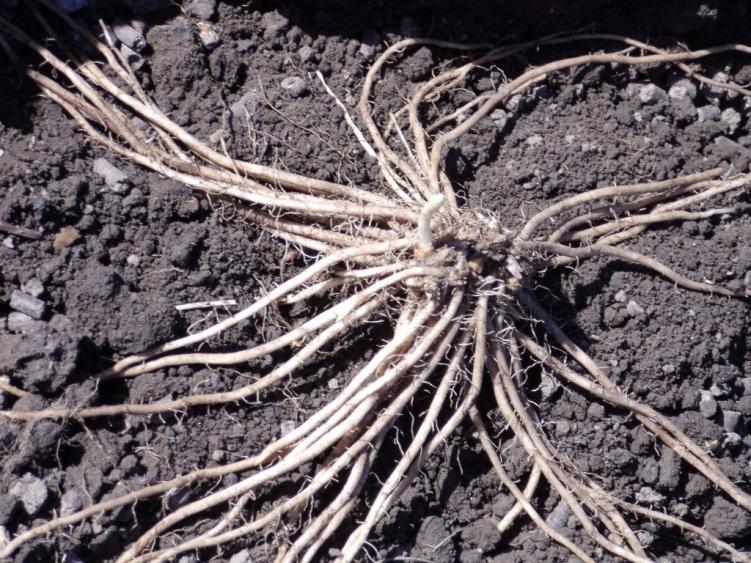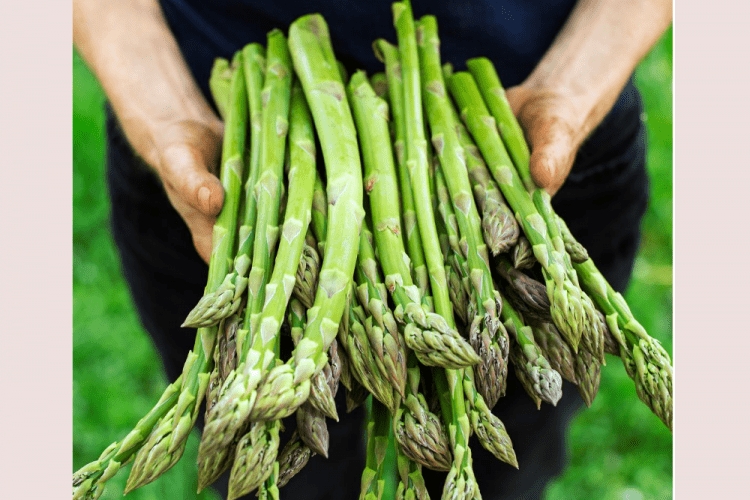Growing asparagus has become more popular over the last few years.
Asparagus is a perennial. All the parts of the spears are edible. You can grow asparagus from crowns or seed.
If you sow asparagus seed it will take 3 years before the asparagus plant will produce a crop. If you plant crowns it will take two years before the asparagus will start to produce a crop.
Asparagus plants will crop for around 10 to 20 years. Each asparagus plant will produce around 20 to 25 spears every year.
Asparagus Crown versus Asparagus Seed

Growing Asparagus – Site, Soil and Planting
Asparagus need a well-drained soil that has a pH of 6.5 to 7.5. They do not like heavy clay or acid soil. Plant them is an area that gets the full sun as a late frost can damage the asparagus crop quite badly.
Prepare and dig the area in the autumn. You will need to dig over the area to a good spade’s depth; you need to remove all the weeds and stones. If your soil doesn’t drain well then you need to add compost and sand or some grit to help with drainage.
You can also make a raised bed for the asparagus crowns. This is what we have done. This way the asparagus has its own bed and can stay happily there for 10 – 20 years.
The crowns can be planted from late March to mid April.
For each row you are going to plant you will need to dig out a trench 25cm deep and around 30cm wide. Fill the bottom of the trench with some well rotted manure or compost then cover the manure with the soil – this will form a ridge.
Place the crowns on the top of the ridge (the roots of the asparagus crown are very long and spidery like) the roots can then drape over either side of the ridge. The crowns need to be planted around 45cm apart.
Cover the crowns up with soil – the top of the crown needs to be around 6 to 8cm below the soil.
Water the crowns in after planting.
Important – If you aren’t planting your asparagus in a raised bed then you need to leave around 60 to 70 cm around the edge of the asparagus bed because their roots can spread a long way.
 Growing Asparagus – General Care
Growing Asparagus – General Care
You will need to give your asparagus bed a feed twice a year with a general purpose fertiliser or fish, blood and bone. Feed in mid March and again in September.
Also water the asparagus bed as needed – but don’t get it too wet.
One really important thing to growing plenty of asparagus is you need to keep the asparagus bed weed free. That’s because their asparagus root system is very shallow – which means you can’t hoe or use a fork to dig out deep rooted weeds. Hand weeding is the simplest and best way to keep them weed free. It’s also important to mulch around the asparagus to help keep them weed free. We use grass clippings as a mulch.
After they have produced the asparagus spears the plants will start to produce beautiful foliage and this will need some form of support. We use stakes in each corner of the raised bed and tied string around it – this helps keep the foliage upright.

In the autumn the foliage will turns a golden yellow and you will need to cut the foliage down to 4cm above ground level.
Harvest Asparagus
Even though the asparagus crowns will produce a few spears in the first 2 years – you must not harvest any asparagus in the first year and only a few in the second year. This allows the asparagus to develop a good root system.
You should harvest the asparagus when they are about 15cm tall. If they get any taller than this, the asparagus could be tougher to eat.
Cut the spears with a sharp knife – you need to cut the spears about 2cm below the soil surface. You will need to check every day and harvest the spears as they are ready – in the growing season asparagus can grow extremely quickly.
Harvest the asparagus for 8 – 10 weeks and then stop. Any shoots that remain will help the asparagus plant to build up the root system.
Asparagus Pests and Diseases
Slugs – can be a problem because they try and eat the young asparagus shoots.
Asparagus beetle – can be another problem. This pest can attack the asparagus foliage.
The Asparagus beetles are black with yellow spots on them. They can be picked off by hand, but if there are too many you will need to spray with derris. The asparagus beetle can over-winter in the soil and debris around the asparagus plants so always keep the site as clean as possible and don’t leave the foliage on top of the plant either compost it or burn it when it’s cut down in autumn. You can also rake the top of the asparagus bed in early spring – taking the top mulched area away – and this keeps the pest down as well.
Another problem with asparagus is over picking in the early years – this will cause the asparagus plants to weaken and often they will only produce very thin spindly spears. It is hard to resist picking the spears, but if you want to have a good crop of asparagus over many years you need to retrain yourself and the plant will pay you back with plenty of spears over many, many years.
Asparagus Varieties
Asparagus plants can be either male or female. The male plants are more productive than the female plants. The males will put their energies into growing edible spears rather than foliage and berries.
Gijnlim – Asparagus Gijnlim is an early Asparagus, it produces high yields and produces medium to thick green spears. This is also a male variety. Starts producing around mid April and continues to crop until July.
Backlim – Asparagus Backlim is a mid to late season male variety, with produces large yields of beautiful smooth spears. It is a very reliable performer in the kitchen garden.
I hope you will enjoy the fun of growing asparagus just as we do.









